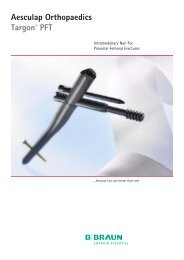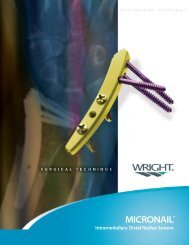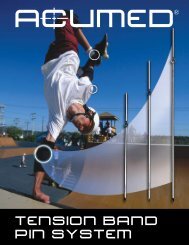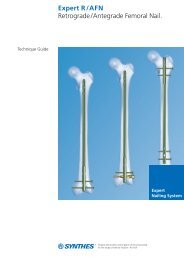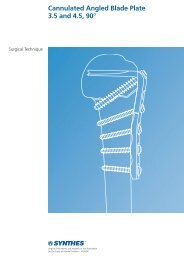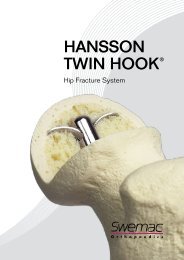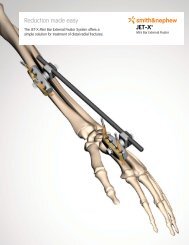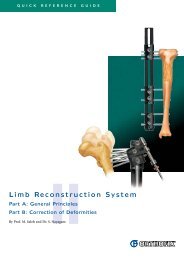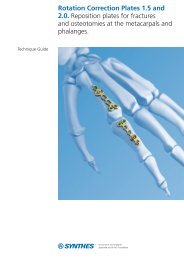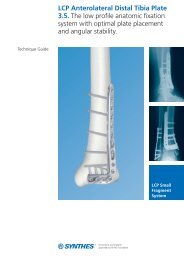2.4 mm Variable Angle LCP Volar Extra-Articular ... - Osteosyntese
2.4 mm Variable Angle LCP Volar Extra-Articular ... - Osteosyntese
2.4 mm Variable Angle LCP Volar Extra-Articular ... - Osteosyntese
You also want an ePaper? Increase the reach of your titles
YUMPU automatically turns print PDFs into web optimized ePapers that Google loves.
Technique Guide<br />
<strong>2.4</strong> <strong>mm</strong> <strong>Variable</strong> <strong>Angle</strong> <strong>LCP</strong> <strong>Volar</strong><br />
<strong>Extra</strong>-<strong>Articular</strong> Distal Radius System.<br />
For fragment-specific fracture fixation<br />
with variable angle locking technology.
Table of Contents<br />
Introduction<br />
<strong>2.4</strong> <strong>mm</strong> <strong>Variable</strong> <strong>Angle</strong> <strong>LCP</strong> <strong>Volar</strong> 2<br />
<strong>Extra</strong>-<strong>Articular</strong> Distal Radius System<br />
Synthes Biomaterials Overview 4<br />
AO Principles 5<br />
Indications 6<br />
Clinical Cases 7<br />
Surgical Technique<br />
Preparation 8<br />
Implantation 9<br />
Optional Bone Void Filler Insertion 15<br />
Closing of Incision 15<br />
Product Information<br />
Screw Overview 16<br />
Plate Overview 18<br />
Instruments 19<br />
<strong>2.4</strong> <strong>mm</strong> <strong>Variable</strong> <strong>Angle</strong> <strong>LCP</strong> Module 22<br />
Image intensifier control<br />
Warning<br />
This description is not sufficient for i<strong>mm</strong>ediate application of<br />
the instrumentation. Instruction by a surgeon experienced in<br />
handling this instrumentation is highly reco<strong>mm</strong>ended.<br />
Synthes 1
<strong>2.4</strong> <strong>mm</strong> <strong>Variable</strong> <strong>Angle</strong> <strong>LCP</strong> <strong>Volar</strong><br />
<strong>Extra</strong>-<strong>Articular</strong> Distal Radius System<br />
<strong>Variable</strong> <strong>Angle</strong> <strong>LCP</strong> (VA-<strong>LCP</strong>)<br />
– The variable angle <strong>LCP</strong> (VA-<strong>LCP</strong>)<br />
holes combined with variable<br />
angle locking screws allow up to<br />
15° off-axis angulation in all<br />
directions<br />
– The variable angle (VA) locking<br />
screws offer a fixed-angle construct<br />
to support the articular surface<br />
– Fixation can be achieved in osteoporotic<br />
bone<br />
– Manufactured in stainless steel<br />
and pure titanium<br />
Plates are available left<br />
or right with 3-hole or<br />
5-hole shaft length<br />
Elongated combi-hole<br />
<strong>LCP</strong> combi-holes allow fixed-angle<br />
locking screw fixation with angular<br />
stability in the threaded section, or<br />
compression with cortex screws in<br />
the non-threaded section<br />
Choice of 4-hole<br />
or 5-hole head<br />
configuration<br />
Fragment-specific fixation<br />
– Due to the 15° off the central axis<br />
the surgeon can perform fragmentspecific<br />
fixation with a<br />
fixed-angle construct (1).<br />
– The nominal angles of the VA<br />
locking screws are identical to the<br />
fixed-angle <strong>2.4</strong> <strong>mm</strong> <strong>LCP</strong> extraarticular<br />
volar distal radius plate (2).<br />
(1)<br />
90°<br />
80°<br />
25°<br />
100°<br />
(2x)<br />
(2)<br />
5° 7.5°<br />
5° 15°<br />
2 Synthes <strong>2.4</strong> <strong>mm</strong> <strong>Variable</strong> <strong>Angle</strong> <strong>LCP</strong> <strong>Volar</strong> <strong>Extra</strong>-<strong>Articular</strong> Distal Radius System Technique Guide
<strong>Variable</strong> angle (VA) locking hole<br />
– The VA locking hole contains four<br />
columns of threads. These<br />
columns provide four points of<br />
threaded locking between the<br />
VA-<strong>LCP</strong> plate and the variable<br />
angle locking screw, forming a<br />
fixed-angle construct at the<br />
desired screw angle (1).<br />
– The head of the <strong>2.4</strong> <strong>mm</strong> VA locking<br />
screw has rounded shape that<br />
facilitates various angles within the<br />
locking hole (2). The shafts of the<br />
<strong>2.4</strong> <strong>mm</strong> VA locking screw and the<br />
standard <strong>2.4</strong> <strong>mm</strong> locking screw<br />
are identical.<br />
– The combi-hole accepts a <strong>2.4</strong> <strong>mm</strong><br />
VA locking screw or a cortex<br />
screw (3).<br />
VA locking hole<br />
(1) (2)<br />
Combi-hole<br />
(3)<br />
VA-<strong>LCP</strong> Drill Guide<br />
– The drill guide allows up to a 15°<br />
angulation around the central axis<br />
of the locking hole.<br />
Synthes 3
Synthes Biomaterials Overview<br />
Synthetic and allogenic bone replacement<br />
materials have the advantage of<br />
uniform quality, unlimited availability<br />
and absence of potential complications<br />
at a donor site.<br />
Additionally, the application of synthetic<br />
and allogenic bone graft substitutes<br />
reduces the duration of the surgery.<br />
Synthes offers a wide range of synthetic<br />
biomaterial products in different<br />
application forms and with distinct biological<br />
properties:<br />
chronOS<br />
chronOS Perfusion Concept<br />
chronOS Inject<br />
Osteoconductive, resorbable, synthetic Enhancing chronOS with biological factors Injectable remodelling<br />
Norian SRS<br />
DBX*<br />
Injectable stability<br />
Osteoinductive power<br />
*Facilitated through Synthes<br />
Furthermore a comprehensive portfolio<br />
of allograft products is available in<br />
selected countries.<br />
For more detailed information about a<br />
specific product or availability of allografts<br />
please contact your local Synthes<br />
representative.<br />
4 Synthes <strong>2.4</strong> <strong>mm</strong> <strong>Variable</strong> <strong>Angle</strong> <strong>LCP</strong> <strong>Volar</strong> <strong>Extra</strong>-<strong>Articular</strong> Distal Radius System Technique Guide
AO Principles<br />
In 1958, the AO formulated four basic principles, which have<br />
become the guidelines for internal fixation. 1 Those principles,<br />
as applied to the <strong>2.4</strong> <strong>mm</strong> <strong>Variable</strong> <strong>Angle</strong> <strong>LCP</strong> <strong>Volar</strong> <strong>Extra</strong>-<br />
<strong>Articular</strong> Distal Radius System, are:<br />
Anatomic reduction<br />
The use of variable angle locking technology allows fragment<br />
specific fixation by providing the flexibility to lock screws in<br />
trajectories that can diverge from the central axis of the plate<br />
hole. <strong>Variable</strong> screw angles provide fixation options for a<br />
variety of fracture patterns.<br />
Stable fixation<br />
<strong>Variable</strong> angle locking screws create a locked construct, providing<br />
angular stability.<br />
Preservation of blood supply<br />
Limited-contact plate design reduces plate-to-bone contact,<br />
limiting vascular trauma. Additionally, locked plates do not<br />
require close contact with the bone.<br />
Early, active mobilization<br />
Early mobilization per standard AO technique creates an environment<br />
for bone healing, expediting a return to optimal<br />
function.<br />
1<br />
Müller ME, Allgöwer M, Schneider R, Willenegger H (1991) AO Manual<br />
of Internal Fixation, 3rd Edition. Berlin; Springer-Verlag<br />
Synthes 5
Indications<br />
The <strong>2.4</strong> <strong>mm</strong> <strong>Variable</strong> <strong>Angle</strong> <strong>LCP</strong> <strong>Volar</strong> <strong>Extra</strong>-<strong>Articular</strong> Distal<br />
Radius Plates are indicated for fixation of intra- and<br />
extra-articular fractures and osteotomies of the distal radius.<br />
6 Synthes <strong>2.4</strong> <strong>mm</strong> <strong>Variable</strong> <strong>Angle</strong> <strong>LCP</strong> <strong>Volar</strong> <strong>Extra</strong>-<strong>Articular</strong> Distal Radius System Technique Guide
Clinical Cases<br />
Case 1<br />
48-year-old female, cause of injury<br />
unknown<br />
Preoperative AP Preoperative lateral Postoperative AP Postoperative lateral<br />
Case 2<br />
71-year-old female, cause of injury<br />
unknown<br />
Preoperative AP Preoperative lateral Postoperative AP Postoperative lateral<br />
Synthes 7
Preparation<br />
Approach<br />
Make a longitudinal incision slightly radial to the flexor carpi<br />
radialis tendon (FCR). Dissect between the FCR and the radial<br />
artery, exposing the pronator quadratus. Detach the pronator<br />
quadratus from the lateral border of the radius and elevate it<br />
toward the ulna.<br />
Important: Leave the volar wrist capsule intact to avoid<br />
devascularization of the fracture fragments and destabilization<br />
of the volar wrist ligaments.<br />
8 Synthes <strong>2.4</strong> <strong>mm</strong> <strong>Variable</strong> <strong>Angle</strong> <strong>LCP</strong> <strong>Volar</strong> <strong>Extra</strong>-<strong>Articular</strong> Distal Radius System Technique Guide
Implantation<br />
1<br />
Reduce fracture and position plate<br />
Instruments for <strong>2.4</strong> <strong>mm</strong> Cortex screws<br />
310.509 Drill Bit 1.8 <strong>mm</strong>, with marking, length<br />
110/85 <strong>mm</strong>, 2-flute, for Quick Coupling<br />
311.430 Handle with Quick Coupling,<br />
length 110 <strong>mm</strong><br />
314.467 Screwdriver Shaft, Stardrive, T8,<br />
self-holding<br />
319.005 Depth Gauge for Screws 2.0<br />
and <strong>2.4</strong> <strong>mm</strong><br />
323.202 Universal Drill Guide <strong>2.4</strong><br />
Reduce the fracture. The reduction method will be fracturespecific.<br />
Apply the plate to fit the extra-articular volar surface<br />
and insert a <strong>2.4</strong> <strong>mm</strong> cortex screw in the elongated hole<br />
in the plate shaft. Adjust the plate position if necessary and<br />
tighten the screw.<br />
The order of screw insertion in the shaft and metaphysis may<br />
vary depending on the fracture pattern and reduction technique.<br />
Synthes 9
Implantation<br />
2<br />
Insert proximal screws<br />
Instruments for <strong>2.4</strong> <strong>mm</strong> VA locking screws<br />
310.509 Drill Bit 1.8 <strong>mm</strong>, with marking, length<br />
110/85 <strong>mm</strong>, 2-flute, for Quick Coupling<br />
323.029 <strong>LCP</strong> Drill Sleeve <strong>2.4</strong>, with Scale up to<br />
30 <strong>mm</strong>, for Drill Bits 1.8 <strong>mm</strong><br />
319.005 Depth Gauge for Screws 2.0 and <strong>2.4</strong> <strong>mm</strong><br />
314.467 Screwdriver Shaft, Stardrive, T8, self-holding<br />
511.776 Torque Limiter 0.8 Nm<br />
311.430 Handle, with Quick Coupling<br />
Optional instrument<br />
03.110.005 Handle for Torque Limiters 0.4/0.8/1.2 Nm<br />
Instruments for <strong>2.4</strong> <strong>mm</strong> cortex screws<br />
310.509 Drill Bit 1.8 <strong>mm</strong>, with marking, length<br />
110/85 <strong>mm</strong>, 2-flute, for Quick Coupling<br />
311.430 Handle, with Quick Coupling<br />
314.467 Screwdriver Shaft, Stardrive, T8, self-holding<br />
319.005 Depth Gauge for Screws 2.0 and <strong>2.4</strong> <strong>mm</strong><br />
323.202 Universal Drill Guide <strong>2.4</strong><br />
Determine where <strong>2.4</strong> <strong>mm</strong> VA locking screws or <strong>2.4</strong> <strong>mm</strong> cortex<br />
screws will be used in the shaft of the plate.<br />
Insert these screws beginning with the most proximal screw.<br />
For VA locking screws, carefully insert the <strong>LCP</strong> drill sleeve <strong>2.4</strong><br />
in line with the hole’s axis until it is seated in the desired locking<br />
hole. Use the 1.8 <strong>mm</strong> drill bit.<br />
Read the screw length directly from the laser mark on the<br />
drill bit, or use the corresponding depth gauge to determine<br />
the screw length.<br />
Technique tip: Insert the self-tapping VA locking screws<br />
with the torque limiter 0.8 Nm.<br />
10 Synthes <strong>2.4</strong> <strong>mm</strong> <strong>Variable</strong> <strong>Angle</strong> <strong>LCP</strong> <strong>Volar</strong> <strong>Extra</strong>-<strong>Articular</strong> Distal Radius System Technique Guide
3<br />
Insert VA locking screws distally<br />
Instruments<br />
03.110.000 VA-<strong>LCP</strong> Drill Guide <strong>2.4</strong>, for Drill Bits<br />
1.8 <strong>mm</strong><br />
314.467 Screwdriver Shaft, Stardrive, T8,<br />
self-holding<br />
310.509 Drill Bit 1.8 <strong>mm</strong>, with marking, length<br />
110/85 <strong>mm</strong>, 2-flute, for Quick Coupling<br />
311.430 Handle, with Quick Coupling<br />
319.005 Depth Gauge for Screws 2.0 and <strong>2.4</strong> <strong>mm</strong><br />
The VA-<strong>LCP</strong> drill guide tip is inserted and keyed into the<br />
cloverleaf design of the VA-<strong>LCP</strong> hole.<br />
Use the funnel-shaped end of the VA-<strong>LCP</strong> drill guide to drill<br />
variable angle holes at the desired angle.<br />
Note: The VA-<strong>LCP</strong> drill guide is inserted into the head of the<br />
plate at the same angle as the <strong>2.4</strong> <strong>mm</strong> threaded drill guide in<br />
the fixed-angle extraarticular plate.<br />
Caution: Do not use <strong>LCP</strong> drill sleeves in VA-locking holes.<br />
Synthes 11
Implantation<br />
4<br />
Drill for VA screw distally<br />
When the VA-<strong>LCP</strong> drill guide is engaged in the VA locking<br />
hole, use the 1.8 <strong>mm</strong> drill bit to drill to the desired depth at<br />
the desired angle.<br />
The funnel of the drill guide allows the drill bit a total angle<br />
variation of 30° (1, 2).<br />
Verify the drill bit angle under C-arm to ensure the desired<br />
angle has been achieved. If necessary, drill at a different<br />
angle and verify again under C-arm.<br />
Use the depth gauge for 2.0 <strong>mm</strong> and <strong>2.4</strong> <strong>mm</strong> screws<br />
to measure the correct screw length.<br />
(1)<br />
The fixed-angle end of the drill guide only allows the drill bit<br />
to follow the nominal trajectory of the locking hole (3).<br />
(2)<br />
(3)<br />
12 Synthes <strong>2.4</strong> <strong>mm</strong> <strong>Variable</strong> <strong>Angle</strong> <strong>LCP</strong> <strong>Volar</strong> <strong>Extra</strong>-<strong>Articular</strong> Distal Radius System Technique Guide
5<br />
Preliminary screw placement<br />
Instruments<br />
311.430 Handle with Quick Coupling,<br />
length 110 <strong>mm</strong><br />
314.467 Screwdriver Shaft, Stardrive, T8, self-holding<br />
Insert the VA locking screws manually with the self retaining<br />
T8 Stardrive screwdriver shaft and Quick Coupling handle<br />
until just before the screw head is seated in the locking hole.<br />
Do not over-tighten the screw so they can be easily removed<br />
if necessary.<br />
6<br />
Confirm proper joint reconstruction<br />
Confirm proper joint reconstruction, screw placement and<br />
screw length using multiple C-arm views. Ensure that the<br />
distal screws are not in the joint using additional views such<br />
as a 10° dorsally tilted, 20° inclined lateral, and 45° pronated<br />
oblique view.<br />
Synthes 13
Implantation<br />
7<br />
Locking of variable angle screws in VA holes<br />
Instruments<br />
511.776 Torque Limiter, 0.8 Nm, with AO/ASIF<br />
Quick Coupling<br />
314.467 511.776 03.110.005<br />
311.430 Handle with Quick Coupling,<br />
length 110 <strong>mm</strong><br />
314.467 Screwdriver Shaft, Stardrive, T8, self-holding<br />
Optional instrument<br />
03.110.002 Torque Limiter, 1.2 Nm, with AO/ASIF<br />
Quick Coupling<br />
03.110.005 Handle for Torque Limiters 0.4/0.8/1.2 Nm<br />
Use the torque limiting attachment to perform the final locking<br />
step for the VA locking screws.<br />
The torque limiting attachment prevents over-tightening and<br />
makes sure that the VA locking screws are securely locked<br />
into the plate.<br />
Caution: A torque limiting attachment is to be used for inserting<br />
VA locking screws in VA holes.<br />
14 Synthes <strong>2.4</strong> <strong>mm</strong> <strong>Variable</strong> <strong>Angle</strong> <strong>LCP</strong> <strong>Volar</strong> <strong>Extra</strong>-<strong>Articular</strong> Distal Radius System Technique Guide
Optional Bone Void Filler Insertion<br />
Closing of Incision<br />
Optional bone void filler insertion<br />
Determine if there is a bone void that requires filling to<br />
maintain reduction and aid in bone healing. Use autogenous<br />
bone graft or a synthetic bone graft or allograft product<br />
(see page 4).<br />
Closing of incision<br />
Use the appropriate method for surgical closure of the<br />
incision.<br />
Synthes 15
Screw Overview<br />
<strong>Variable</strong> angle locking screws<br />
<strong>2.4</strong> <strong>mm</strong> <strong>Variable</strong> angle locking screws,<br />
with Stardrive recess<br />
– Threaded, spherical head locks securely into the threaded<br />
VA-<strong>LCP</strong> holes to provide angular stability at angles determined<br />
by the surgeon<br />
– Locked screws allow unicortical screw fixation and load<br />
transfer to near cortex<br />
– 6 <strong>mm</strong> to 30 <strong>mm</strong> lengths (2 <strong>mm</strong> increments)<br />
– Self-tapping tip<br />
Important: Use of 08. or 1.2 Nm TLA torque limiting attachment<br />
required<br />
Cortex screws<br />
<strong>2.4</strong> <strong>mm</strong> Cortex screws, self-tapping,<br />
with Stardrive recess<br />
– For use in round or combi-holes<br />
– Low-profile head in the plate holes<br />
– Used to provide compression or neutral fixation<br />
– 6 <strong>mm</strong> to 30 <strong>mm</strong> lengths (2 <strong>mm</strong> increments)<br />
– Self-tapping tip<br />
16 Synthes <strong>2.4</strong> <strong>mm</strong> <strong>Variable</strong> <strong>Angle</strong> <strong>LCP</strong> <strong>Volar</strong> <strong>Extra</strong>-<strong>Articular</strong> Distal Radius System Technique Guide
2.7 <strong>mm</strong> Cortex screws, self-tapping,<br />
with Stardrive recess<br />
– For use in combi-holes<br />
– Used to provide compression or neutral fixation<br />
– 10 <strong>mm</strong> to 30 <strong>mm</strong> lengths (2 <strong>mm</strong> increments)<br />
– Self-tapping tip<br />
Notes<br />
– For information on fixation principles using conventional<br />
and locked plating techniques, please refer to the <strong>LCP</strong><br />
Technique Guide (036.000.019).<br />
– The Stardrive recess in the screw head offers improved<br />
torque transfer, high strength, and self-retention of screws,<br />
when compared to cruciform and hexagonal drives. Please<br />
note in the surgical report that a screw with Stardrive recess<br />
has been used. This will remind the surgeon to have a<br />
Stardrive screwdriver available for screw removal.<br />
Synthes 17
Plate Overview<br />
<strong>2.4</strong> <strong>mm</strong> <strong>Variable</strong> <strong>Angle</strong> <strong>LCP</strong> <strong>Volar</strong> <strong>Extra</strong>-<strong>Articular</strong><br />
Distal Radius Plates, Stainless Steel<br />
Left plates<br />
Right plates<br />
02.110.203 02.110.204<br />
02.110.201 02.110.202<br />
02.110.207<br />
02.110.208<br />
02.110.205<br />
02.110.206<br />
All plates are also available sterile<br />
18 Synthes <strong>2.4</strong> <strong>mm</strong> <strong>Variable</strong> <strong>Angle</strong> <strong>LCP</strong> <strong>Volar</strong> <strong>Extra</strong>-<strong>Articular</strong> Distal Radius System Technique Guide
<strong>2.4</strong> <strong>mm</strong> <strong>Variable</strong> <strong>Angle</strong> <strong>LCP</strong> <strong>Volar</strong> <strong>Extra</strong>-<strong>Articular</strong><br />
Distal Radius Plates, Titanium<br />
Left plates<br />
Right plates<br />
04.110.203 04.110.204<br />
04.110.201 04.110.202<br />
04.110.207<br />
04.110.208<br />
04.110.205<br />
04.110.206<br />
All plates are also available sterile<br />
Synthes 19
Instruments<br />
Special instruments for VA-<strong>LCP</strong> screw insertion in<br />
VA holes<br />
03.110.000 VA-<strong>LCP</strong> Drill Guide <strong>2.4</strong>, for Drill Bits<br />
1.8 <strong>mm</strong><br />
Optional<br />
03.110.002 Torque Limiter, 1.2 Nm, with AO/ASIF<br />
Quick Coupling<br />
20 Synthes <strong>2.4</strong> <strong>mm</strong> <strong>Variable</strong> <strong>Angle</strong> <strong>LCP</strong> <strong>Volar</strong> <strong>Extra</strong>-<strong>Articular</strong> Distal Radius System Technique Guide
Instruments*<br />
310.509 Drill Bit 1.8 <strong>mm</strong>, with marking,<br />
length 110/85 <strong>mm</strong>, 2-flute,<br />
for Quick Coupling<br />
311.430 Handle with Quick Coupling,<br />
length 110 <strong>mm</strong><br />
314.467 Screwdriver Shaft, Stardrive, T8,<br />
self-holding<br />
314.468 Holding Sleeve for Screws Stardrive<br />
<strong>2.4</strong> <strong>mm</strong>, T8, for Screwdriver Shafts<br />
3.5 <strong>mm</strong>, for No. 314.467<br />
319.005 Depth Gauge for Screws 2.0 and<br />
<strong>2.4</strong> <strong>mm</strong>, measuring range up to 40 <strong>mm</strong><br />
323.029 <strong>LCP</strong> Drill Sleeve <strong>2.4</strong>, with Scale up to<br />
30 <strong>mm</strong>, for Drill Bits 1.8 <strong>mm</strong><br />
323.202 <strong>2.4</strong> <strong>mm</strong> Universal Drill Guide<br />
511.776 Torque Limiter, 0.8 Nm, with AO/ASIF<br />
Quick Coupling<br />
*All listed instruments are part of the standard locking Distal Radius System <strong>2.4</strong><br />
Synthes 21
Instruments<br />
Optional instruments*<br />
310.260 Drill Bit 2.7 <strong>mm</strong>, length 100/75 <strong>mm</strong>,<br />
2-flute, for Quick Coupling<br />
310.530 Drill Bit <strong>2.4</strong> <strong>mm</strong>, length 100/75 <strong>mm</strong>,<br />
2-flute, for Quick Coupling<br />
310.534 Drill Bit 2.0 <strong>mm</strong>, with marking, length<br />
110/85 <strong>mm</strong>, 2-flute, for Quick Coupling<br />
319.010 Depth Gauge for Screws 2.7 to 4.0 <strong>mm</strong>,<br />
measuring range up to 60 <strong>mm</strong><br />
323.260 Universal Drill Guide 2.7<br />
03.110.005 Handle for Torque Limiters 0.4/0.8/1.2 Nm<br />
*All listed instruments are part of the standard locking Distal Radius System <strong>2.4</strong><br />
22 Synthes <strong>2.4</strong> <strong>mm</strong> <strong>Variable</strong> <strong>Angle</strong> <strong>LCP</strong> <strong>Volar</strong> <strong>Extra</strong>-<strong>Articular</strong> Distal Radius System Technique Guide
<strong>2.4</strong> <strong>mm</strong> <strong>Variable</strong> <strong>Angle</strong> <strong>LCP</strong> Module<br />
The module contains the following plates, screws and<br />
instruments:<br />
Module with content<br />
01.111.416 VA-<strong>LCP</strong> Distal Radius Plates <strong>2.4</strong>,<br />
extraarticular, Pure Titanium<br />
01.111.417 VA-<strong>LCP</strong> Distal Radius Plates <strong>2.4</strong>,<br />
extraarticular, Stainless Steel<br />
Synthes 23
<strong>2.4</strong> <strong>mm</strong> <strong>Variable</strong> <strong>Angle</strong> <strong>LCP</strong> Module<br />
Implants in module<br />
<strong>2.4</strong> <strong>mm</strong> <strong>Variable</strong> <strong>Angle</strong> <strong>LCP</strong> <strong>Volar</strong> <strong>Extra</strong>-<strong>Articular</strong><br />
Distal Radius Plates<br />
Stainless Steel Titanium Head Shaft<br />
Holes Holes<br />
02.110.201 04.110.201 5 3 right<br />
02.110.203 04.110.203 5 3 left<br />
02.110.202 04.110.202 5 5 right<br />
02.110.204 04.110.204 5 5 left<br />
02.110.205 04.110.205 4 3 right<br />
02.110.207 04.110.207 4 3 left<br />
02.110.206 04.110.206 4 5 right<br />
02.110.208 04.110.208 4 5 left<br />
<strong>2.4</strong> <strong>mm</strong> <strong>Variable</strong> <strong>Angle</strong> Locking Screws,<br />
with Stardrive recess<br />
Stainless Steel Titanium Length (<strong>mm</strong>) Quantity<br />
02.210.106 04.210.106 6 optional<br />
02.210.108 04.210.108 8 optional<br />
02.210.110 04.210.110 10 3<br />
02.210.112 04.210.112 12 3<br />
02.210.114 04.210.114 14 3<br />
02.210.116 04.210.116 16 3<br />
02.210.118 04.210.118 18 3<br />
02.210.120 04.210.120 20 3<br />
02.210.122 04.210.122 22 3<br />
02.210.124 04.210.124 24 3<br />
02.210.126 04.210.126 26 3<br />
02.210.128 04.210.128 28 3<br />
02.210.130 04.210.130 30 3<br />
24 Synthes <strong>2.4</strong> <strong>mm</strong> <strong>Variable</strong> <strong>Angle</strong> <strong>LCP</strong> <strong>Volar</strong> <strong>Extra</strong>-<strong>Articular</strong> Distal Radius System Technique Guide
Instruments in module<br />
03.110.000 VA-<strong>LCP</strong> Drill Guide <strong>2.4</strong>,<br />
for Drill Bits 1.8 <strong>mm</strong><br />
X92.120 Kirschner Wire 1.25 <strong>mm</strong> with trocar tip,<br />
length 150 <strong>mm</strong><br />
511.776 Torque Limiter, 0.8 Nm,<br />
with AO/ASIF Quick Coupling<br />
Additionally available<br />
03.110.002 Torque Limiter, 1.2 Nm,<br />
with AO/ASIF Quick Coupling<br />
X92.160 Kirschner Wire 1.6 <strong>mm</strong> with trocar tip,<br />
length 150 <strong>mm</strong>
Synthes GmbH<br />
Eimattstrasse 3<br />
CH-4436 Oberdorf<br />
www.synthes.com Presented by:<br />
0123<br />
036.000.575 SE_173646 AA 30080032 © 09/2008 Synthes, Inc. or its affiliates All rights reserved Synthes, <strong>LCP</strong> and Stardrive are trademarks of Synthes, Inc. or its affiliates



